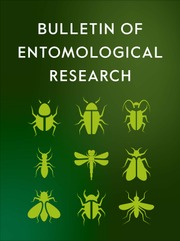Crossref Citations
This article has been cited by the following publications. This list is generated based on data provided by
Crossref.
TRAUGOTT, M.
BELL, J. R.
BROAD, G. R.
POWELL, W.
VAN VEEN, F. J. F.
VOLLHARDT, I. M. G.
and
SYMONDSON, W. O. C.
2008.
Endoparasitism in cereal aphids: molecular analysis of a whole parasitoid community.
Molecular Ecology,
Vol. 17,
Issue. 17,
p.
3928.
von Berg, K.
Traugott, M.
Symondson, W.O.C.
and
Scheu, S.
2008.
The effects of temperature on detection of prey DNA in two species of carabid beetle.
Bulletin of Entomological Research,
Vol. 98,
Issue. 3,
p.
263.
LEE, WONHOON
KIM, HYOJOONG
LIM, JONGOK
CHOI, HWAL‐RAN
KIM, YEYEUN
KIM, YANG‐SU
JI, JEONG‐YEON
FOOTTIT, ROBERT G.
and
LEE, SEUNGHWAN
2011.
Barcoding aphids (Hemiptera: Aphididae) of the Korean Peninsula: updating the global data set.
Molecular Ecology Resources,
Vol. 11,
Issue. 1,
p.
32.
GAGNON, A.‐È.
DOYON, J.
HEIMPEL, G. E.
and
BRODEUR, J.
2011.
Prey DNA detection success following digestion by intraguild predators: influence of prey and predator species.
Molecular Ecology Resources,
Vol. 11,
Issue. 6,
p.
1022.
Hatteland, B.A.
Symondson, W.O.C.
King, R.A.
Skage, M.
Schander, C.
and
Solhøy, T.
2011.
Molecular analysis of predation by carabid beetles (Carabidae) on the invasive Iberian slugArion lusitanicus.
Bulletin of Entomological Research,
Vol. 101,
Issue. 6,
p.
675.
Davies, Andrew P
Carr, Christopher M
Scholz, Brad C G
and
Zalucki, Myron P
2011.
Using Trichogramma Westwood (Hymenoptera: Trichogrammatidae) for insect pest biological control in cotton crops: an Australian perspective.
Australian Journal of Entomology,
Vol. 50,
Issue. 4,
p.
424.
ROUGERIE, RODOLPHE
SMITH, M. ALEX
FERNANDEZ-TRIANA, JOSE
LOPEZ-VAAMONDE, CARLOS
RATNASINGHAM, SUJEEVAN
and
HEBERT, PAUL D.N.
2011.
Molecular analysis of parasitoid linkages (MAPL): gut contents of adult parasitoid wasps reveal larval host.
Molecular Ecology,
Vol. 20,
Issue. 1,
p.
179.
SINT, DANIELA
RASO, LORNA
KAUFMANN, RÜDIGER
and
TRAUGOTT, MICHAEL
2011.
Optimizing methods for PCR‐based analysis of predation.
Molecular Ecology Resources,
Vol. 11,
Issue. 5,
p.
795.
Hagler, James R.
2011.
An immunological approach to quantify consumption of protein-tagged Lygus hesperus by the entire cotton predator assemblage.
Biological Control,
Vol. 58,
Issue. 3,
p.
337.
OEHM, JOHANNES
JUEN, ANITA
NAGILLER, KARIN
NEUHAUSER, SIGRID
and
TRAUGOTT, MICHAEL
2011.
Molecular scatology: how to improve prey DNA detection success in avian faeces?.
Molecular Ecology Resources,
Vol. 11,
Issue. 4,
p.
620.
Gagnon, Annie-Ève
Heimpel, George E.
Brodeur, Jacques
and
Szolnoki, Attila
2011.
The Ubiquity of Intraguild Predation among Predatory Arthropods.
PLoS ONE,
Vol. 6,
Issue. 11,
p.
e28061.
Staudacher, Karin
Wallinger, Corinna
Schallhart, Nikolaus
and
Traugott, Michael
2011.
Detecting ingested plant DNA in soil-living insect larvae.
Soil Biology and Biochemistry,
Vol. 43,
Issue. 2,
p.
346.
Kobayashi, Tetsuya
Takada, Mayura
Takagi, Shun
Yoshioka, Akira
and
Washitani, Izumi
2011.
Spider predation on a mirid pest in Japanese rice fields.
Basic and Applied Ecology,
Vol. 12,
Issue. 6,
p.
532.
HRCEK, JAN
MILLER, SCOTT E.
QUICKE, DONALD L. J.
and
SMITH, M. ALEX
2011.
Molecular detection of trophic links in a complex insect host–parasitoid food web.
Molecular Ecology Resources,
Vol. 11,
Issue. 5,
p.
786.
Kitaev, Konstantin A
Udalov, Maksim B
and
Benkovskaya, Galina V
2011.
Molecular-genetic methods of the investigation of trophic relations hips in the agrocoenosis.
Ecological genetics,
Vol. 9,
Issue. 4,
p.
15.
Moreno-Ripoll, R.
Gabarra, R.
Symondson, W.O.C.
King, R.A.
and
Agustí, N.
2012.
Trophic relationships between predators, whiteflies and their parasitoids in tomato greenhouses: a molecular approach.
Bulletin of Entomological Research,
Vol. 102,
Issue. 4,
p.
415.
Schoeller, Erich N.
Husseneder, Claudia
and
Allison, Jeremy D.
2012.
Molecular evidence of facultative intraguild predation by Monochamus titillator larvae (Coleoptera: Cerambycidae) on members of the southern pine beetle guild.
Naturwissenschaften,
Vol. 99,
Issue. 11,
p.
913.
DEROCLES, STEPHANE A. P.
PLANTEGENEST, MANUEL
SIMON, JEAN‐CHRISTOPHE
TABERLET, PIERRE
and
LE RALEC, ANNE
2012.
A universal method for the detection and identification of Aphidiinae parasitoids within their aphid hosts.
Molecular Ecology Resources,
Vol. 12,
Issue. 4,
p.
634.
Jenkins, Cheryl
Chapman, Toni A.
Micallef, Jessica L.
and
Reynolds, Olivia L.
2012.
Molecular Techniques for the Detection and Differentiation of Host and Parasitoid Species and the Implications for Fruit Fly Management.
Insects,
Vol. 3,
Issue. 3,
p.
763.
Symondson, William O. C.
2012.
Biodiversity and Insect Pests.
p.
166.

